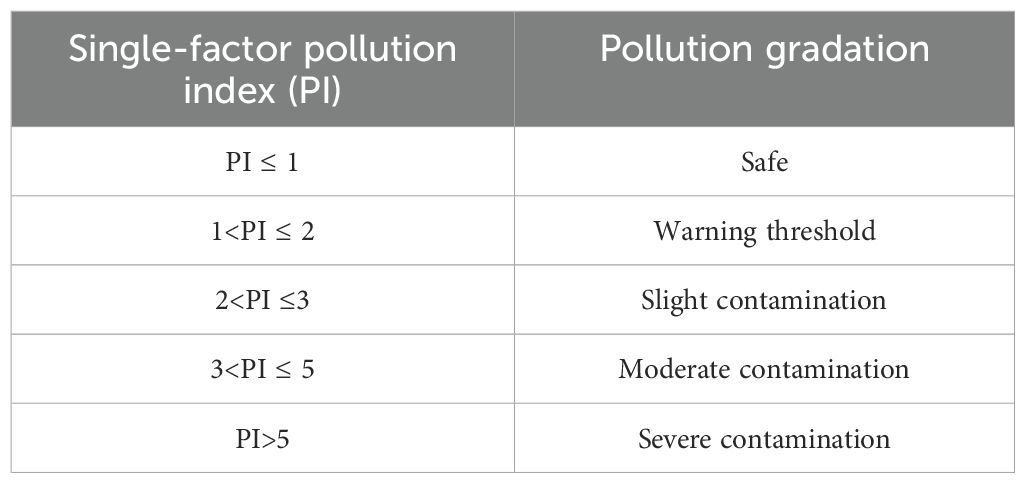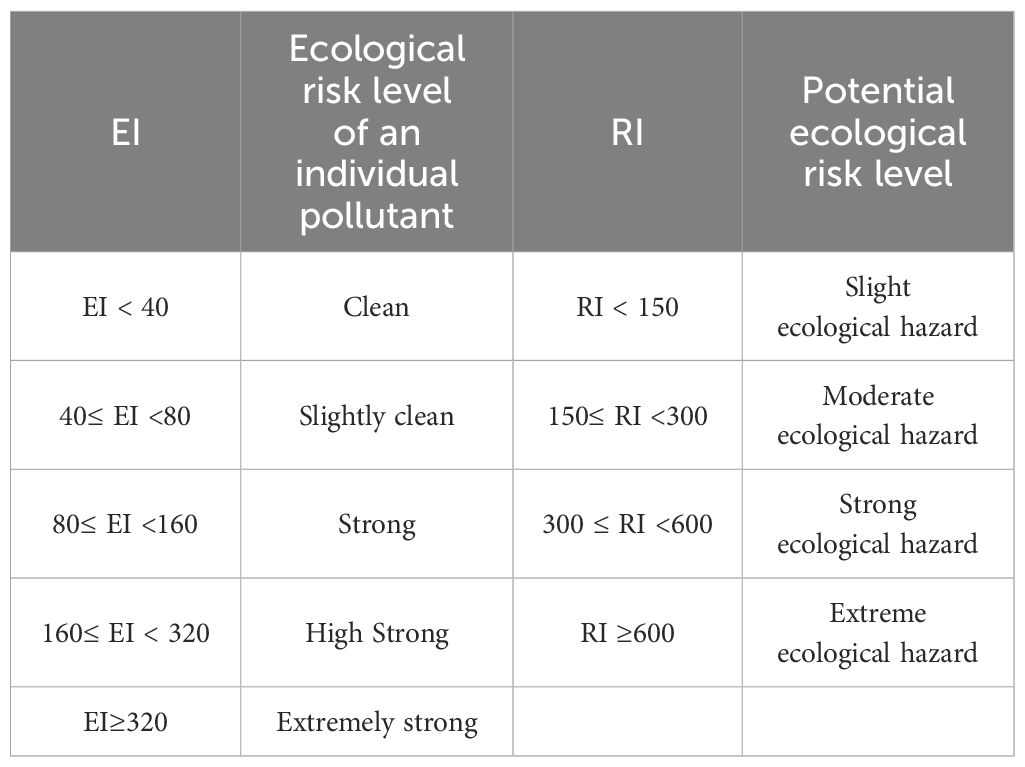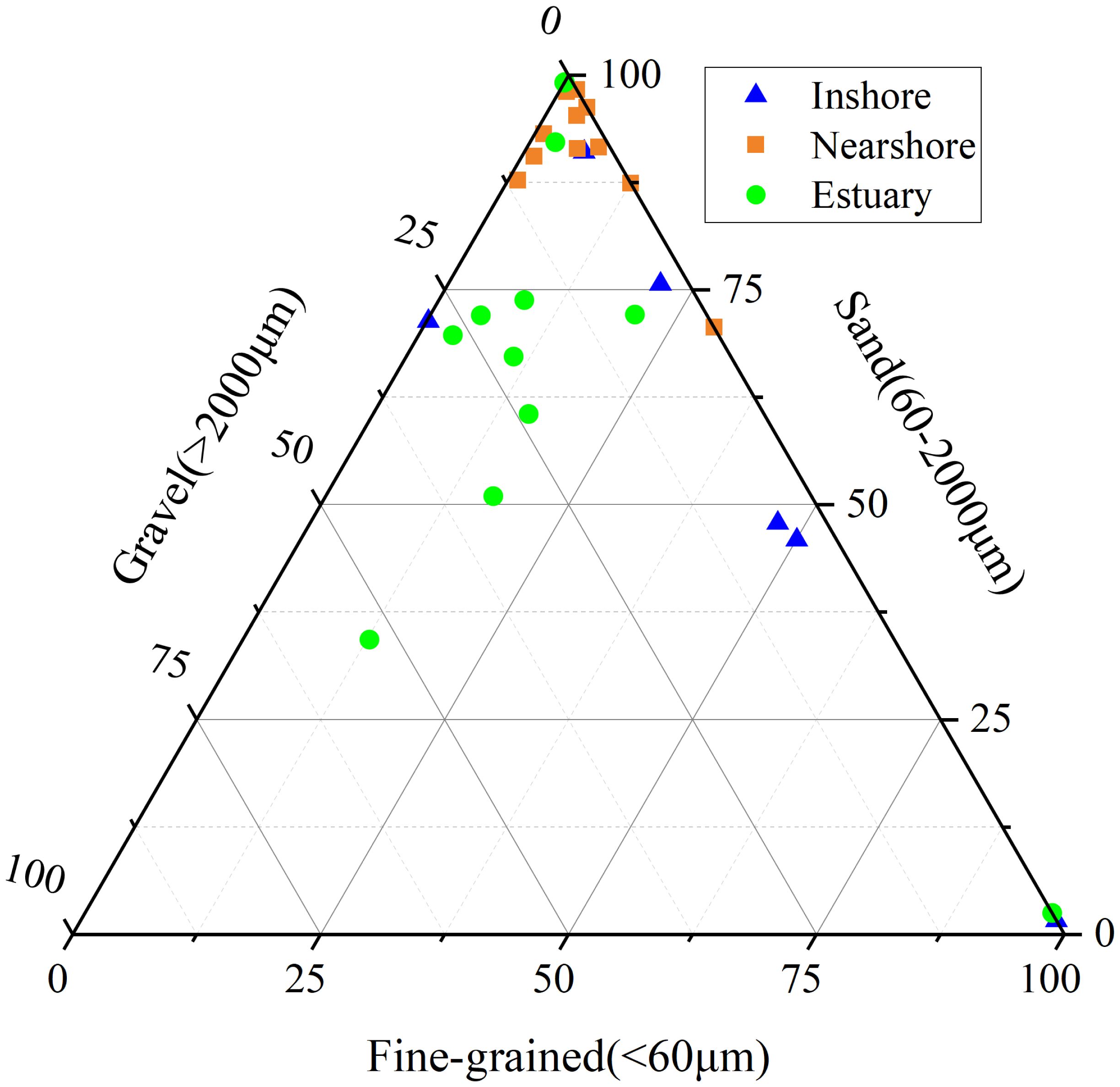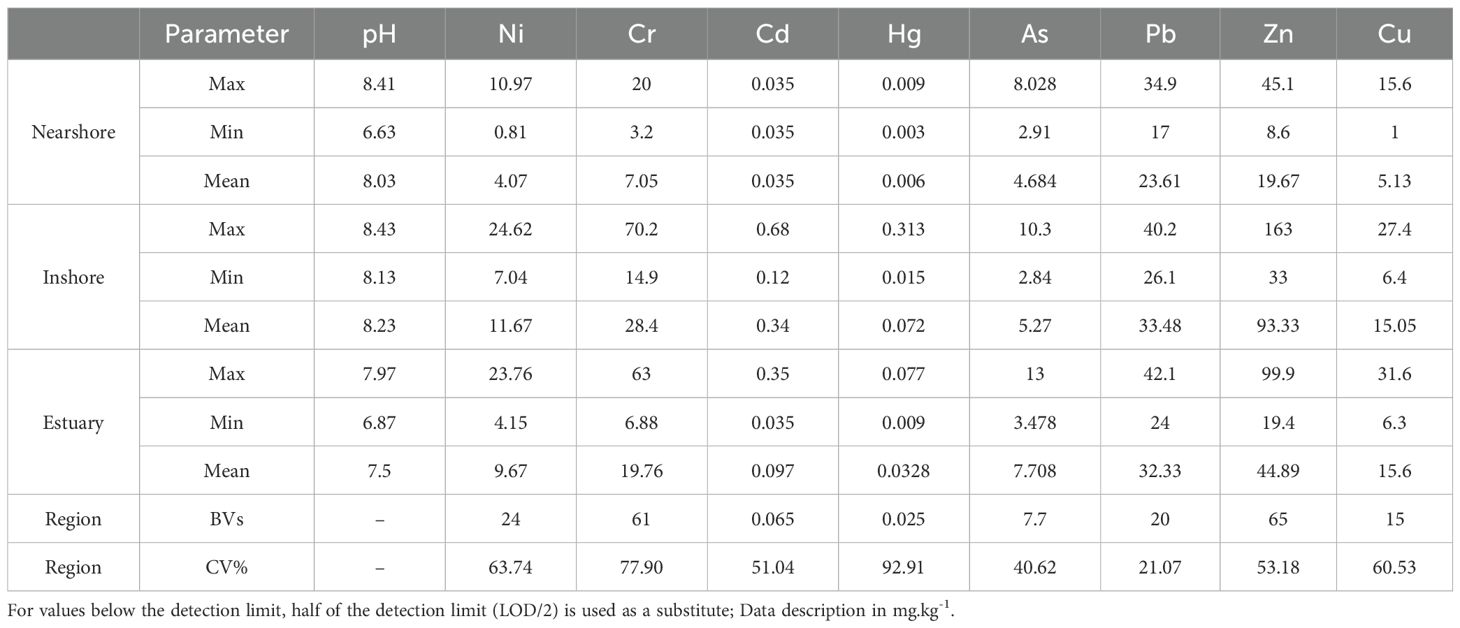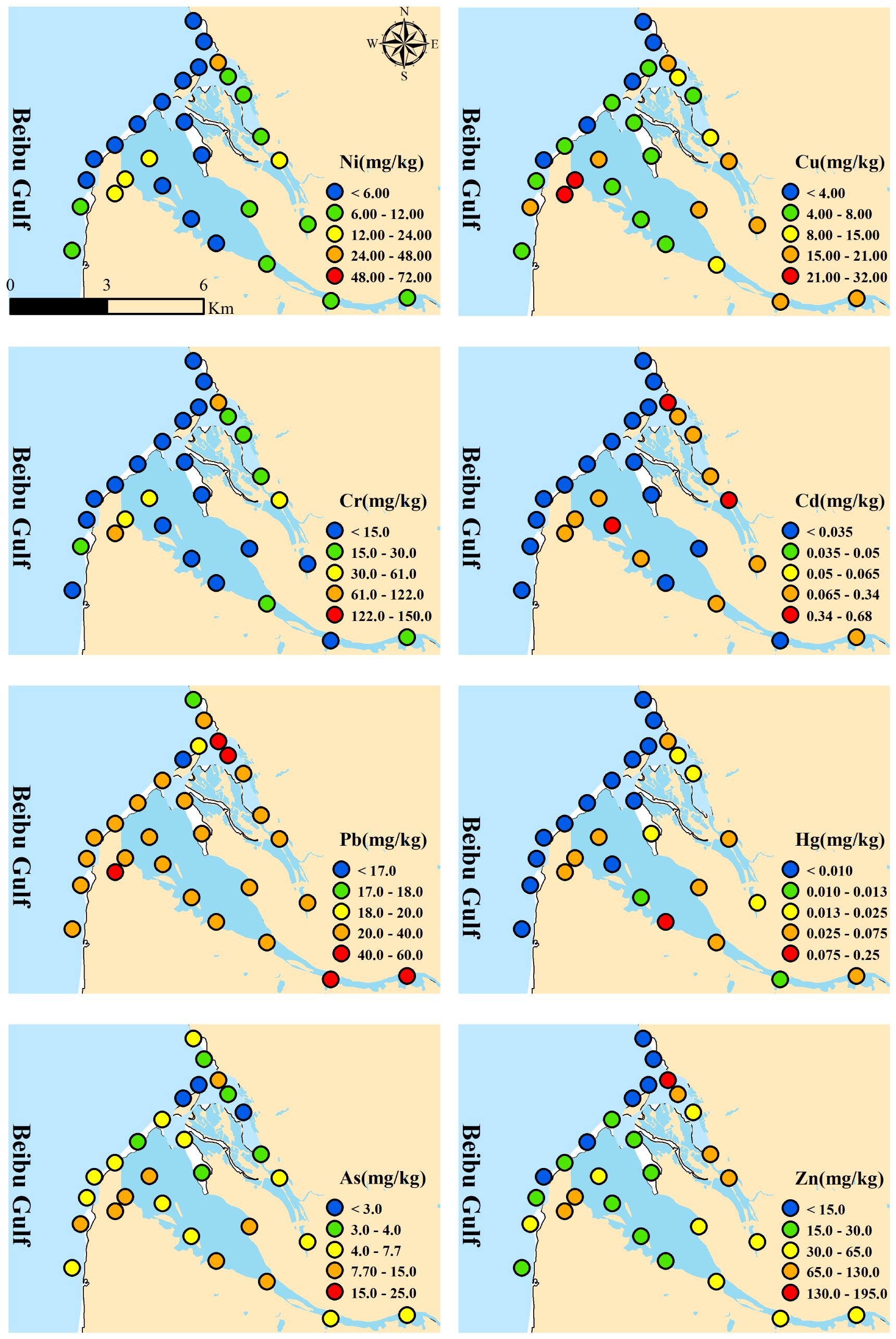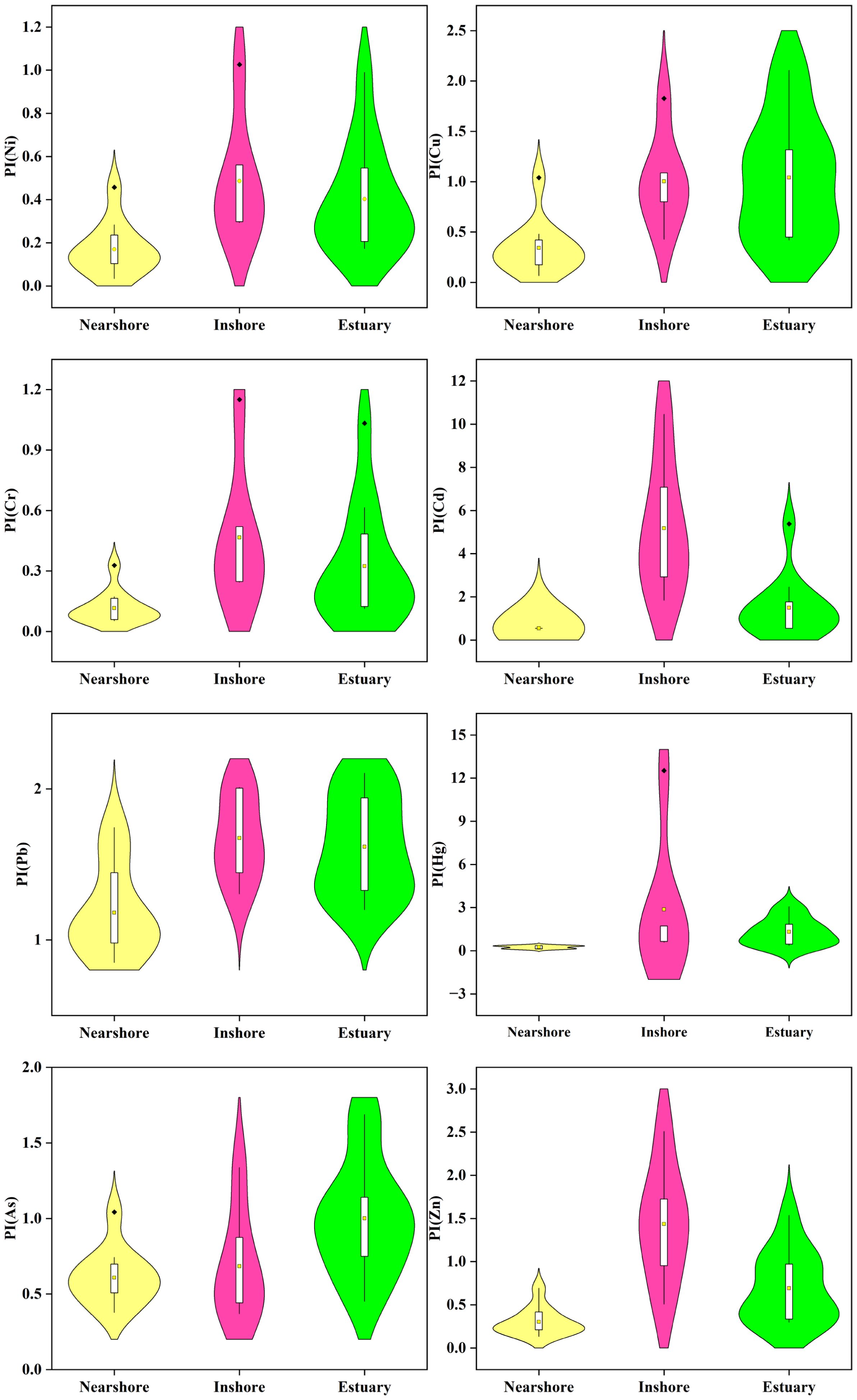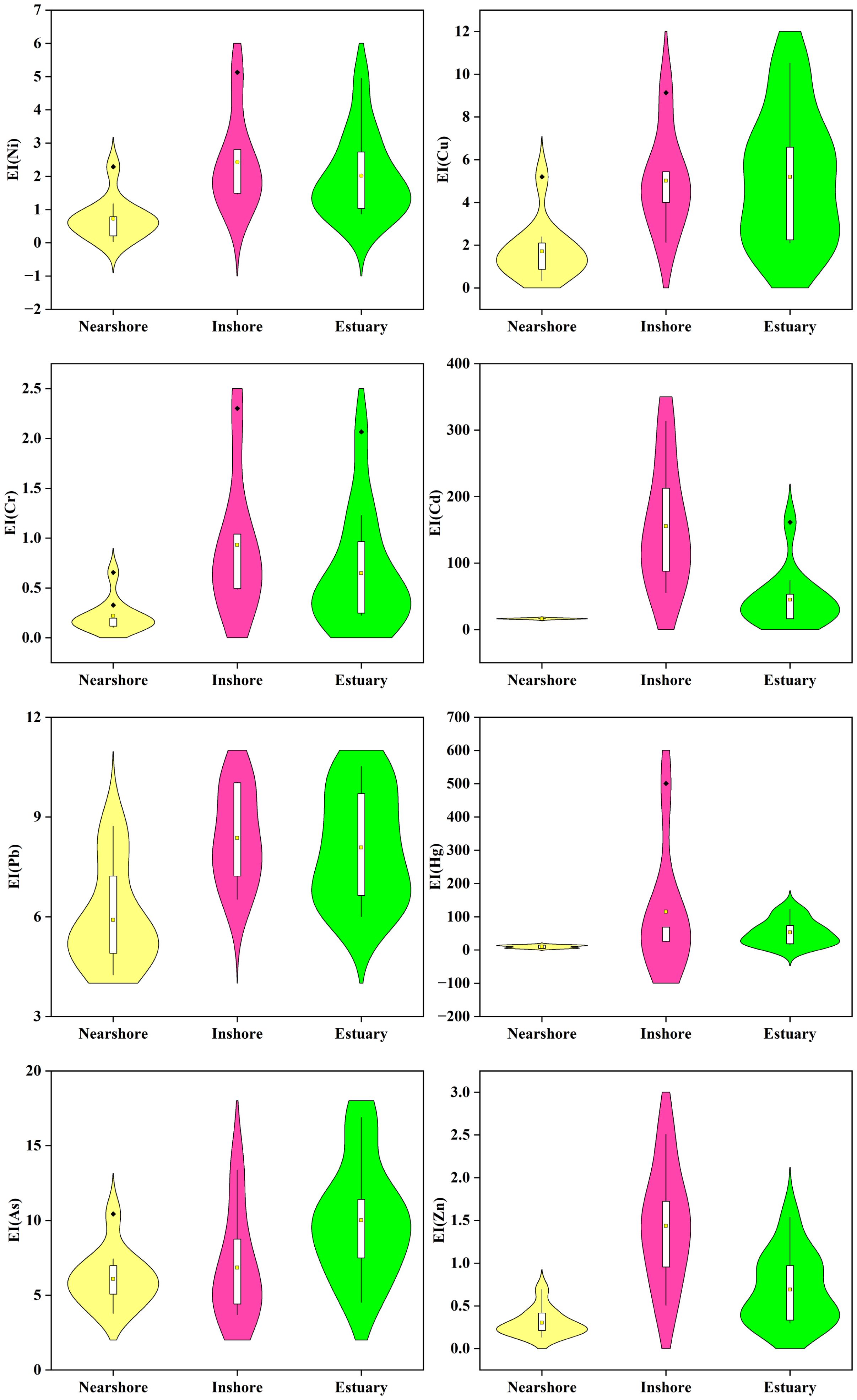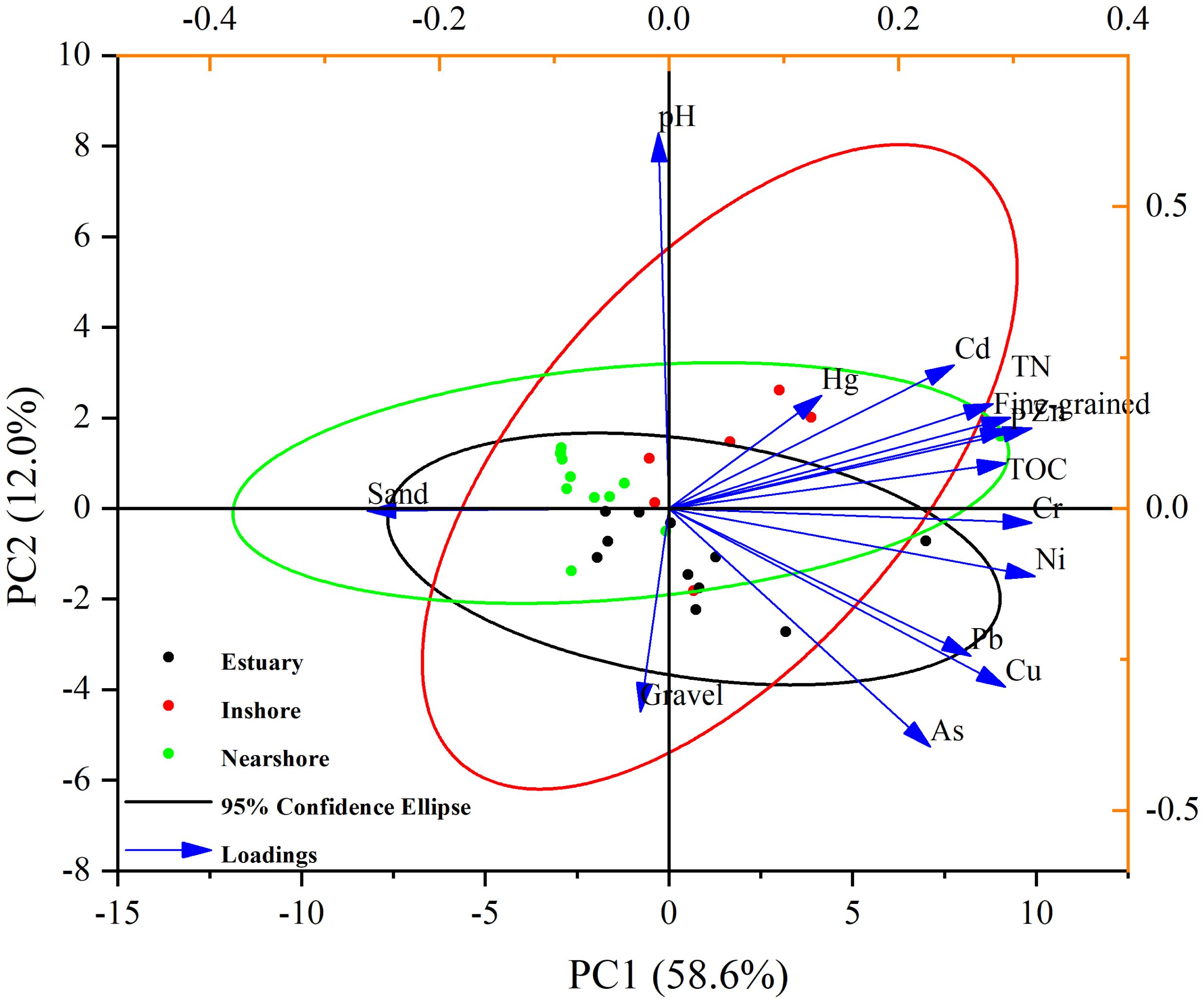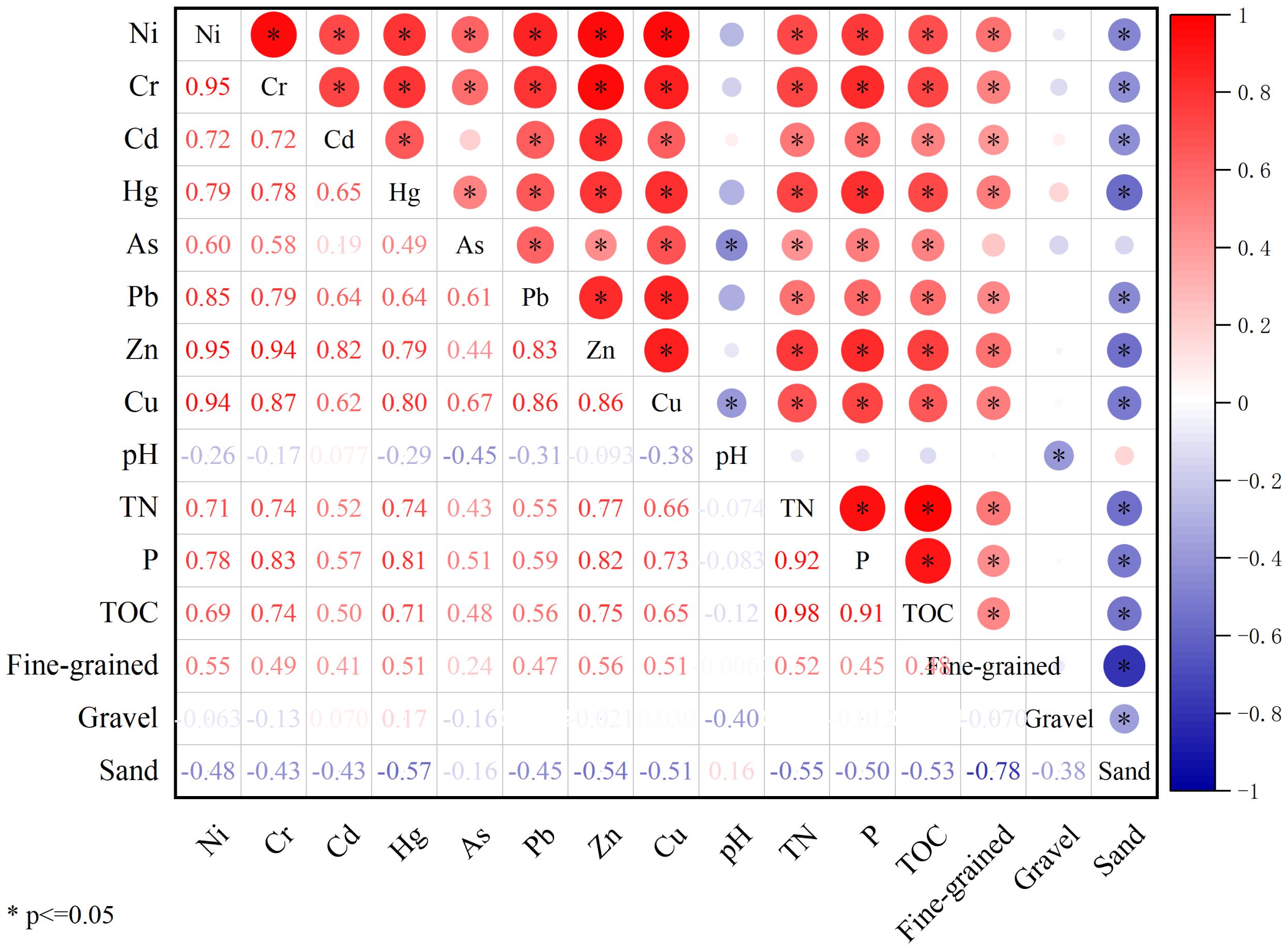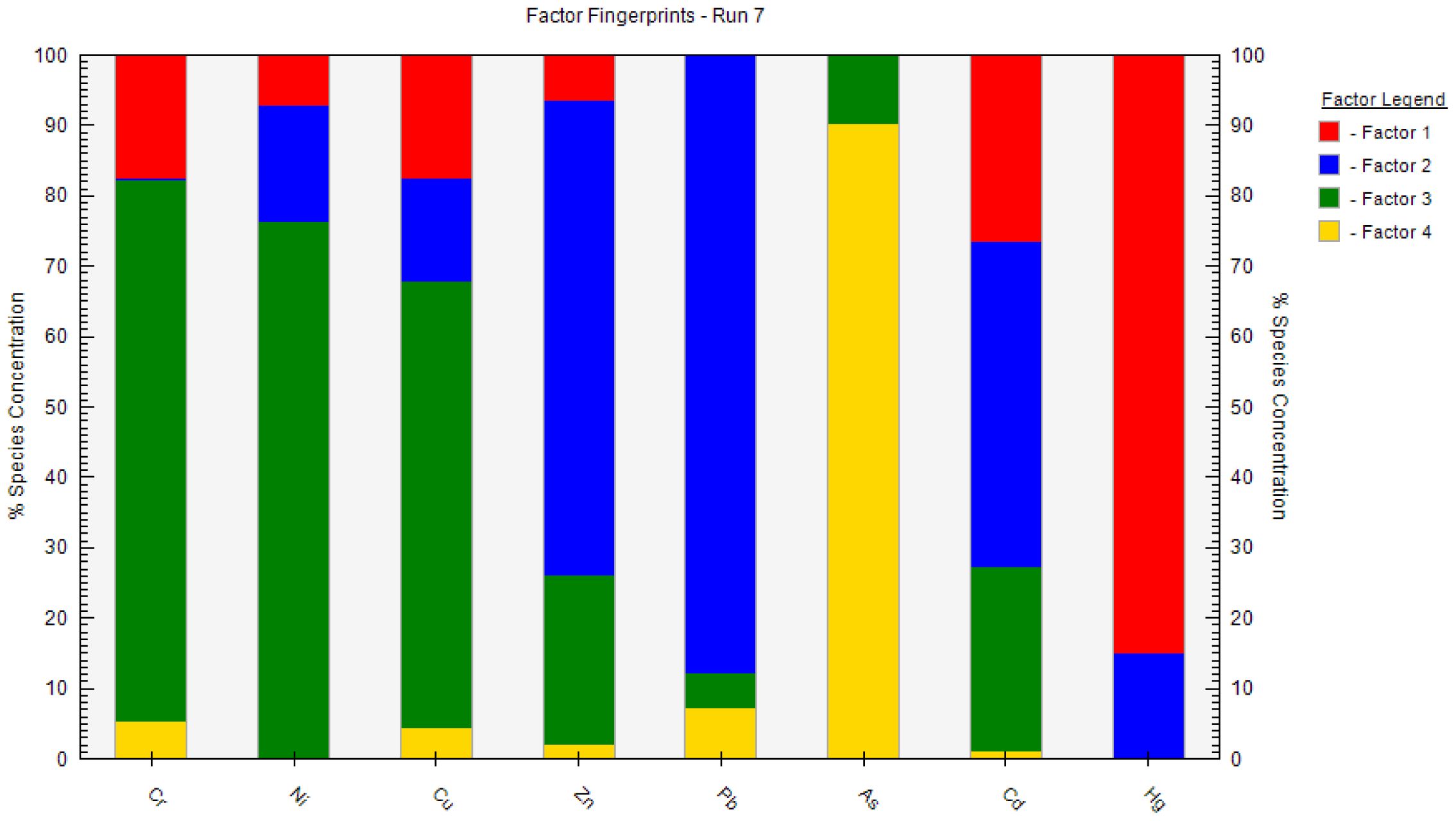- 1Haikou Marine Geological Survey Center, China Geological Survey, Haikou, China
- 2Guiyang Baiyun District Municipal Development and Construction Co., Ltd., Guiyang, China
- 3Ministry Key Laboratory of Low-carbon Green Agriculture in Tropical Region of China; National Agricultural Experimental Station for Agricultural Environment, Institute of Environment and Plant Protection, Chinese Academy of Tropical Agricultural Sciences, Haikou, China
Within the framework of global biogeochemical cycles, estuaries function as a critical interface that connects terrestrial and marine ecosystems. We assessed the heavy metal pollution risk in the Changhua River estuary area. The assessment focused on pollution characteristics, spatial distribution, and ecological risks, while also identifying potential origins of metallic elements through the application of correlation analysis, principal component analysis (PCA), and Positive Matrix Factorization (PMF) models. The results showed that: (1) Sediments were predominantly sandy and weakly alkaline properties, with significant spatial heterogeneity in metallic concentrations. The concentration of metals, compared to their background values (BVs), could be ranked as: Nearshore: Pb > As > Cd > Cu > Zn > Hg > Ni > Cr; Inshore: Cd > Hg > Pb > Zn > Cu > As > Ni > Cr; Estuary: Pb > Cd > Hg > Cu > Zn > Ni > Cr. Particularly, Cd and Hg in inshore sediments registered a mean concentration surpassing their BVs by 417.95% and 187.33%, respectively. (2) The sampling locations presented varying levels of ecological risk. Moderate ecological risk (150 ≤ RI < 300) accounted for 24.14% of the sites, primarily located in inshore and estuarine areas, while extreme ecological risk (300≤RI) was observed in 6.90% of the sites, concentrated within inshore regions. Hg and Cd were identified as the most hazardous metals. (3) Regarding metallic sources, Hg mainly originated from coal burning, while Pb, Zn, and Cd were likely linked to anthropogenic activities associated with port operations. In contrast, Cr, Ni, and Cu were primarily derived from natural and agricultural sources, and As was mainly associated with the residual accumulation of fertilizers and herbicides. Overall, human activities, including agriculture, aquaculture, and port transport, are the primary origins of metallic contamination in the estuarine sediments. Effective management and regular monitoring of port activities are essential for the governance of the estuarine environment. Such practices can yield valuable insights for continuous risk analysis, thereby supporting the ecological health and resilience of these vital environments.
1 Introduction
Estuaries function as transitional zones between rivers and oceans and can provide essential ecosystem roles and benefits (Guen et al., 2019; Boicourt, 1983). These areas frequently accumulate and retain pollutants originating from human activities, such as nutrient compounds, polycyclic aromatic hydrocarbons, and metallic elements (Bantan et al., 2020; Guo et al., 2020; Kumar et al., 2015). As reported, substantial anthropogenic inputs have placed considerable pressure on estuaries and contributed to increased pollution levels (Negrin et al., 2021; Yin et al., 2016; Chapman and Wang, 2001). Estuarine systems are shaped by dual forces: river-derived elements like sediment transport and freshwater flow, as well as oceanic influences such as tidal patterns and saline mixtures (Cooper, 2001; Sherwood et al., 1990). The mixing of saline and freshwater induces the flocculation and deposition of fine-grained particles and heavy metals, elevating pollutant concentrations in the water column and sediments, making estuarine environments among the most contaminated ecosystems globally (Hamzeh et al., 2016; Sánchez-Moyano and García-Asencio, 2010; Zhang and Savenije, 2018; Lopez et al., 2020; Hu et al., 2024). The prevalence and enduring nature of metallic contaminants have emerged as a significant issue for environmental researchers, owing to their capacity for bioaccumulation, ecological harm, and resistance to natural degradation processes (Truchet et al., 2021; MaChado et al., 2016; Papagiannis et al., 2004). Metallic elements exist in various environmental media, including soil, suspended particulate matter, water, organisms, and sediment. The concentrations of metals dissolved in water remain relatively low (Kumar et al., 2020; Xie and Wang, 2020; Wang et al., 2012), while suspended particulate matter acts as a major carrier for these metals (Zeng et al., 2020; Yao et al., 2016).
Sedimentary layers exhibit a notable ability to retain metallic elements, frequently functioning as a repository or accumulation site. Additionally, it has the potential to release these elements into the water column, which can result in secondary pollution in the environment (Xiao et al., 2021; Ahmad et al., 2020; Yi et al., 2011; Pekey, 2006). The spatial patterns of metallic elements within sedimentary layers are strongly linked to sediment attributes, shaped by external influences such as absorption potential and hydrological linkages (Jia et al., 2021; Li et al., 2020; Bantan et al., 2020). Therefore, gaining a comprehensive insight into sedimentary conditions is essential for understanding the buildup of metallic contaminants in estuarine sediments (Bi et al., 2017; Ye et al., 2012; Krupadam et al., 2007). Nevertheless, a knowledge gap exists regarding the influence of the sedimentary environment on the characteristics of metallic contaminants in estuaries. Further research is necessary to elucidate the movement of metallic contaminants from estuarine deposits into adjacent coastal marine areas.
Metallic elements can derive from natural processes, including the geochemical breakdown of soil and rock formations, as well as anthropogenic activities like farming practices, resource extraction, and manufacturing operations (Zhao et al., 2020a; Jia et al., 2020; Pekey, 2006). Various evaluation indexes have been applied to assess metallic contamination, such as the geo-accumulation index (Igeo) (Muller, 1969), the contamination factor (CF) (Hakanson, 1980), the enrichment factor (EF) (Sutherland, 2000), and the potential ecological risk index (Hakanson, 1980). The use of background values (BVs) is a fundamental requirement for accurately evaluating metallic contamination using these indices. Currently, the establishment of geochemical baselines, the assessment of pre-industrial sediment metallic concentrations, and the determination of soil BVs in surrounding areas emerge as the three dominant methods for establishing sediment metallic BVs (Wang et al., 2019; Chen et al., 2019). Nevertheless, these approaches possess inherent constraints. The geochemical baseline reflects a snapshot of concentrations at a particular moment, encompassing both natural and human-induced factors, which may lead to an underestimation of sediment metallic contamination (Wang et al., 2019). The use of the pre-industrial metallic concentrations is appropriate for small-scale studies, such as those conducted in lakes with specific sedimentation rates; however, inaccuracies can arise when analyzing extensive drainage basins, primarily due to variations in sedimentation rates (Gu et al., 2022). Applying soil BVs as proxies for sediment BVs is effective under specific geographical scenarios, like regions near riverbanks, but may introduce significant biases in other environments (Luo et al., 2022). Therefore, selecting an appropriate method to establish BVs will enhance the precision of assessments regarding metallic contamination in sediments. In addition to evaluating metallic contamination in sediments, identifying the origins of metallic pollutants is crucial for effective pollution management. The positive matrix factorization (PMF) model has proven to be effective as a receptor-based method, widely utilized in numerous investigations to discern and measure the origins of metallic elements in both soil and sedimentary samples (Jiang et al., 2024; Proshad et al., 2022; Wu et al., 2021). In recent years, research on trace metals in Hainan has increased; however, most studies have primarily focused on individual river estuaries, coastal waters, or specific sections of estuarine environments, with limited attention given to the distribution and transformation of heavy metals (HMs) within an integrated river-estuary-ocean dynamic system. Moreover, existing studies are often constrained by insufficient sampling density, and assessments of pollution levels and potential ecological risks predominantly rely on single-index methods, limiting analytical depth. Currently, pollution source apportionment lacks comprehensive approaches such as multivariate statistical analysis, isotopic tracing, or model coupling. Additionally, the influence of hydrodynamic conditions on sedimentary heavy metal concentrations remains underexplored, necessitating more systematic and in-depth investigations (Xia et al., 2011; Fu et al., 2013; Hu et al., 2013; Kuang et al., 2021; Fu Z. et al., 2023; Fan et al., 2024).
To address existing research gaps, this investigation conducted an in-depth examination and source identification of metallic elements in surface sediments from the downstream and estuarine sections of the Changhua River. The study aimed to: (i) evaluate and contrast the accumulation of metallic pollutants, including As, Cd, Cr, Cu, Hg Ni, Pb, and Zn, in sediments using numerical calculations and index-based analytical methods; (ii) map the spatial distribution of these elements and identify high-concentration zones through spatial analysis techniques; and (iii) uncover the key drivers influencing the sources of metallic pollutants in sediments by integrating PMF modeling, correlation analysis, and principal component analysis (PCA). The findings of this study will enhance the understanding of the driving mechanisms of sedimentary metal pollution, particularly in economically developed regions characterized by complex geomorphology and dynamic hydrological conditions. Furthermore, the results provide a theoretical foundation and scientific support for sediment metal pollution management, contributing to the sustainable development of similar riverine environments.
2 Materials and methods
2.1 Sample collection, processing, and analysis
2.1.1 Sample collection
Figure 1 displays a geographic representation of the research region, encompassing a wide array of sampling locations. The region was categorized into three distinct regions based on the region’s human activity patterns (agriculture, industry, fisheries, and urban distribution), hydrodynamic conditions, and geographical characteristics (open rivers and semi-enclosed bays) (Wu et al., 2024, 2025), i.e., nearshore (B1-B11), inshore (B12-B17) and estuary (B18-B29). The estuarine area contains intensive aquaculture zones, while the inshore area is a semi-enclosed marine zone characterized by significant shipping activity and functions as an actively used harbor. Due to the semi-enclosed nature of the inshore sea, substantial volumes of agricultural and household effluents are released into the Beibu Gulf through multiple upstream waterways, leading to local accumulation of pollutants (Wang and Wang, 2007).
2.1.2 Data sources and quality control
In July 2023, the project team collected surface sediment samples from 29 sites. All sampling locations were georeferenced using a Global Positioning System (GPS) receiver, and samples were collected from estuaries, bays, and nearshore areas to represent the entire estuarine region. At each sampling site, surface sediments (0–10 cm) were collected from three positions at 3-meter intervals. The procedures for sample collection, storage, and transportation of samples were carried out in strict accordance with the requirements of the code. All samples were kept clean during the sample collection, transportation, and storage.
The sediment samples collected in this study were analyzed at the Analytical Testing Laboratory of the Haikou Marine Geological Survey Center. Before measurement, the samples were air-dried, ground, and sieved through a 160-mesh sieve, followed by microwave digestion to prepare the test solutions. The concentrations of Ni, Cu, and Zn were measured using an X-ray fluorescence spectrometer (Axios Pw4400), while As and Hg concentrations were determined using a dual-channel atomic fluorescence spectrometer (AFS-8530). Additionally, Cr, Cd, and Pb were analyzed using an inductively coupled plasma mass spectrometer (ICP-Q). The grain size was determined according to the guidelines specified in the Specification for Marine Investigation (GB12763.1-2007, State Oceanic Administration, PR China), and sediment grain size analysis was conducted using a PSA 1190 LD laser diffraction particle size analyzer.
All analyses were performed in triplicate, and the accuracy and precision of the experiments were assessed using standard reference materials. The standard deviation was less than 10%, and the recovery rates of the standard materials ranged from 89% to 107%. The significance level was set to p <= 0.05. The detection limits for Cu, Cr, Ni, Pb, Zn, As, Hg, and Cd were 1.2, 2.0, 1.5, 2.0, 2.0, 0.01, 0.002, and 0.07 mg·kg−¹, respectively.
2.2 Methods for ecological risk assessment
2.2.1 Geo-accumulation index
The Igeo index serves as a comparative metric for assessing metallic concentrations in soil samples relative to their BVs (Xu et al., 2019). Since the late 1960s, this index has been extensively utilized to assess contamination from metallic elements in soil. The formula for determining the Igeo is presented as below:
In Equation 1, where Cn represents the detected level of the metallic element in the collected samples, while Bn denotes the geochemical background concentration. The constant 1.5 accounts for potential natural variability in BVs. Generally, Igeo can be categorized into seven levels, as indicated by the grading standards displayed in Table 1.
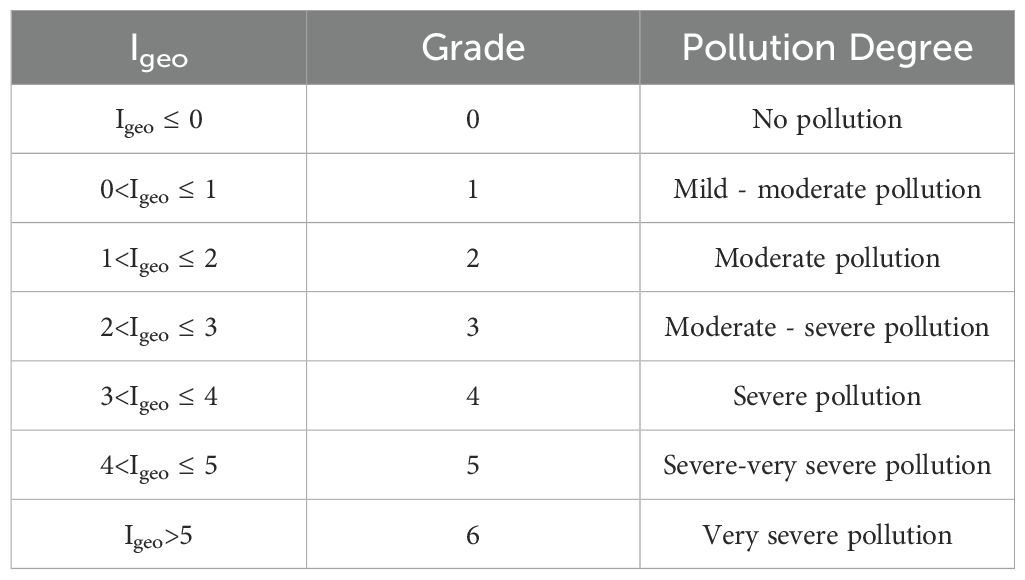
Table 1. Igeo grading standards (Wolswijk et al., 2020).
2.2.2 Single-factor pollution index
The PI index has emerged as an effective tool for long-term pollution monitoring. This index offers a straightforward yet robust method for quantifying metallic contamination and assessing the impacts of anthropogenic actions (Chai et al., 2021; Tian et al., 2017). Table 2 illustrates the contamination levels categorized according to the PI index (Wang et al., 2022; Cai et al., 2019a). The formula for calculating the PI index is presented as below:
In Equation 2, where Ci denotes the detected level of a pollutant, and Si indicates the BV of the pollutant.
2.2.3 Assessment framework for ecological risk
The RI index is frequently employed to assess possible environmental hazards in sediment (Hakanson, 1980). The evaluation formula is expressed as follows:
In Equations 3 and 4, where RI refers to the overall ecological hazards posed by metallic elements, EI denotes the specific risk associated with individual metals, and Ti indicates their toxicity coefficients. The respective response coefficients for Ni, Cr, Cd, Hg, As, Pb, Zn and Cu are 5, 2, 30, 40, 10, 5, 1, and 5, as documented in studies by Yüksel et al. (2022) and Fang et al. (2019). Table 3 provides the updated classification of comprehensive RI levels (Fei et al., 2019; Hakanson, 1980).
2.2.4 Source analysis of metallic contamination in sediment
2.2.4.1 Coefficient of variation
The CV can be used as a robust metric for assessing the spatial heterogeneity of metallic concentrations in sediment. According to the research by Phil-Eze (2010), CV values below 20% indicate low variability, values between 20~51% reflect moderate variability, and values ranging 51~100% denote high variability. Typically, a low CV suggests the predominance of diffuse or uniform pollution sources, whereas a high CV is indicative of notable differences in pollutant sources, often associated with discrete point-source inputs.
2.2.4.2 Positive matrix factorization
EPA PMF 5.0 is a positive definite short-matrix factorization tool developed by the United States Environmental Protection Agency, which is widely used in environmental data analysis, including atmospheric particulate matter, water quality and sediment. The model decompositions the observed environmental data into a factor contribution matrix and a factor spectrum matrix. Helps identify potential sources of pollution and quantify their contribution to pollutant concentrations in the environment. In addition, it is a multivariate factor analysis technique, employs the least iterative squares algorithm (Vaccaro et al., 2007). Unlike other methods, it does not necessitate predefined source or receptor component spectra. During factorization, error estimation is applied to individual data points, enhancing the treatment of missing or erroneous data. This method avoids generating negative values in matrix decomposition, thereby improving result reliability (Yu et al., 2021). The PMF model breaks down the original receptor data matrix (X) into three components: a factor score matrix (G), a factor loading matrix (F), and a residual matrix (E) (Norris et al., 2014). The equation for this decomposition can be expressed as follows:
In Equation 5, where p stands for the total number of factors, while i denotes a specific sample, and j indicates a particular element. The matrix Xij is constructed from the concentration of element j in sample i. Gik signifies the contribution of factor k to sample i, Fkj describes the species distribution for each source and Eij represents the residual matrix. All parameters in the above calculation process are unitless.
In the calculation process, the signal-to-noise ratio of the data needs to be analyzed first, If the signal-to-noise ratio (SNR) is greater than 2, the data are suitable for the model. The number of factors needs to be run and adjusted for many times, and the Q value, residual value and R2 are fully considered to make the calculation results stable. Then, the predicted value of the model is compared with the measured value. The fitting curve R2 is above 0.5, indicating that the measured value is highly correlated with the simulated value, and the representative factor number can be selected.
2.3 Data analysis and processing
Descriptive statistics were conducted using Microsoft Excel 2022. Origin 2024 was utilized to conduct correlation analysis and PCA modeling for determining the sources of metallic elements in the soil. The EPA PMF 5.0 tool was applied for source apportionment, while ArcGIS 10.8 was used to create maps of the research region and sampling locations. All other figures were generated using Origin 2024.
3 Results and discussion
3.1 Analysis of particle size distribution in the sediments
The influence of sediment grain size on metallic concentrations is multifaceted. The ternary diagram in Figure 2 illustrates the distribution of sediment particle sizes. The data reveals that the surface sedimentary deposits are predominantly fine-grained and sandy in composition. Fine-grained sediments possess a larger specific surface area and a greater adsorption capacity, which typically leads to the immobilization of more metallic elements, thereby reducing their bioavailability and mobility (Wang et al., 2013; Chen et al., 2016; Zhou et al., 2020). In contrast, coarse-grained sediments often lead to the migration and bioaccumulation of metallic elements. Studies indicate that nearshore sediments are predominantly composed of sand, accounting for 70.64 - 98.26% of the total sediment composition, while fine-grained sediments contribute only 0.8 - 29.36%. Fine-grained sediments in the nearshore inner shelf of the study area are influenced by fluvial inputs, tidal forces, and wave energy, which collectively regulate sediment transport and the spatial distribution of metals. (Wentworth, 1922; Syvitski et al., 2005; Xiao et al., 2016; Wu et al., 2024, 2025). However, in estuarine and inshore areas, fine-grained sediments can reach maximum proportions of 98.39% and 97.52%, respectively. Notably, gravel is more prevalent in estuarine and inner bay regions, with a proportion up to 52.91%.
3.2 Spatial distribution of metallic elements in the sediments
This section aims to elucidate the spatial variation in metallic contamination across nearshore, inshore, and estuarine zones. Samples were classified according to field records and sampling locations for subsequent comparative analysis. In the Changhua River estuary, the organic carbon content in the sediments ranged from 0.02% to 1.15%, with a mean value of 0.33%. The pH levels varied between 6.63 and 8.43, averaging 7.85, a value lower than those observed in the nearshore and inshore areas, indicating that the estuarine sediments are alkaline (Table 4). Metallic concentrations exhibited notable spatial heterogeneity across the research region (Figure 3). In nearshore sediments, average metallic concentrations remained below the corresponding BVs, which can be attributed to broad concentration ranges and prevailing hydrodynamic conditions. However, in inshore sediments, the metal elements including Cd, Hg, Pb, and Zn displayed average concentrations exceeding their BVs by approximately 417.95%, 187.33%, 67.41%, and 43.59%, respectively. Cr and Pb were identified as the most abundant elements in the inshore region, reaching peak concentrations up to 0.68 and 0.313 mg kg−¹, respectively. Additionally, in the estuarine sediments, Ni, Cr, and Zn concentrations remained within acceptable limits, whereas Pb and Hg showed enrichment, registering 61.67% and 31.33% above their BVs, respectively. Across the entire research region, Cd and Pb emerged as the most accumulated elements, attaining peak concentrations up to 0.68 and 42.10 mg kg−¹, respectively.
The coefficients of variation (CV) further reveal the spatial variability of metallic concentrations in the sediments. The CVs for Pb, As, and Cd ranged from 21.07% to 51.04%, indicating moderate variability. In contrast, the CVs for Ni, Cr, Hg, Zn, and Cu ranged from 53.18% to 92.91%, indicative of higher variability. Notably, exceptionally high concentrations of Cd and Pb were detected at locations B12, B16, B18, and B19, while higher Zn levels were recorded at location B12, suggesting pronounced point source pollution. These observations imply that anthropogenic activities have likely contributed to the enrichment of metallic elements in the sediments. Consistent with the findings of Pan et al. (2020) and Zhao et al. (2019), a higher CV indicates elevated human influence on soil metallic content, and thus it can act as a preliminary marker for anthropogenic impact.
In summary, the pronounced variability in metallic concentrations across different regions may not reliably reflect true pollution levels due to inherent spatial heterogeneity and differences in BVs. Consequently, a comprehensive assessment of sediment contamination necessitates the integration of additional quantitative indices, such as Igeo, PI, EI, and RI, which explicitly account for these baseline variations.
3.3 Evaluation of ecological hazards and origins of metallic elements in the sediments
To assess metallic contamination in sediments more accurately, it is necessary to consider the BVs of sediments. Therefore, several quantitative indices, including the Geo-accumulation Index (Igeo), Pollution Index (PI), and Risk Index (RI), were employed to evaluate the metallic pollution levels in the sediments.
Figure 4 displays the Igeo values for metallic elements in the sedimentary samples collected from the research region. From the figure, while the inshore area has largely prevented widespread pollution, certain sites in other regions exhibit severe contamination. The influence of anthropogenic activities surpasses that of geological weathering. The average Igeo values for As, Cd, Cr, Cu, Hg, Ni, Pb, and Zn in the sediments across the entire region ranged from -1.36 to -0.68, -1.48 to 1.56, -3.93 to -1.94, -2.46 to -0.71, -2.74 to -0.15, -3.48 to -1.79, -0.38 to 0.14, and -2.46 to -0.23, respectively. The Igeo values for Cd and Pb in the inshore area reached maximum averages of 1.56 and 0.14, respectively, indicating moderate pollution for Cd and slight pollution for Pb. The Igeo results are comparable to those observed in other regions of Hainan Island, such as Doongzhaigang, Sibiwan, and Wenchang (Wang et al., 2024; Fu et al., 2024; Zhao et al., 2025). The average Igeo values for the other metallic elements remained below 0, suggesting no accumulation risk.
The PI values for the research region varied significantly, ranging from 0.37 to 1.69 for As, 0.54 to 10.46 for Cd, 0.05 to 1.15 for Cr, 0.07 to 2.51 for Cu, 0.12 to 12.52 for Hg, 0.03 to 1.03 for Ni, 0.85 to 2.11 for Pb, and 0.13 to 2.51 for Zn. Among these elements, Hg, Cd, Pb, Cu and Zn exhibited the greatest variability in PI values across the regions, and certain samples recorded a PI value greater than 2.0 (Figure 5). This observation indicates that the sediments in the research region are contaminated with these metallic elements.
Across the research region, the EI indices for metallic elements in the sediments were ranked as: Cd> Hg> As> Pb> Cu> Ni> Zn for the nearshore region, Cd> Hg> Pb> As> Cu> Ni> Zn for the inshore area, and Hg> Cd> As> Pb> Cu> Ni> Zn for the estuarine area (Figure 6). In both the inshore and estuarine regions, Hg and Cd exhibited the greatest ecological threats, with mean EI values exceeding 160. Consistent with the findings from the Nandu River estuary, Cd and Hg exhibited the highest RI values. Furthermore, most sampling sites fell within the medium potential ecological hazard range (Ouyang et al., 2024).
The RI indices for metallic elements in the sediments ranged from 32.20 to 58.54 (mean of 41.13) in the nearshore region, from 103.36 to 665.22 (mean of 295.34) in the inshore region, and from 46.65 to 208.74 (mean of 123.99) in the estuarine region (Figure 7). Hg and Cd exhibited increased ecological risks in the inner and estuarine channel regions. From these RI values, it can be noted that a significant proportion of areas were anthropogenically affected. Specifically, 24.14% of the locations recorded RI values ranging from 150 to 300, reflecting moderate ecological risk, while 6.90% registered RI values exceeding 300, indicating high ecological risk. A notably high RI value of 665 was noted in the inner area, which represented a severe ecological risk.

Figure 7. Spatial distribution of the RI index for metallic elements in the sediments across the research region.
3.4 Identification of the origins of metallic elements in the sediments
Principal Component Analysis (PCA) has proven effective in distinguishing the possible sources of metallic elements in sediments. Here, two principal components (PCs) accounted for a combined 70.6% of the overall variability in the sedimentary samples (Figure 8). The first principal component (PC1) represented 58.6% of this variability and exhibited strong positive correlations with Hg, Cd, Zn, Cr, and Ni. Additionally, PC 1 also showed a strong positive correlation with TOC, TN, and fine-grained particles. The second principal component (PC2) accounted for 12.0% of the overall variability and displayed significant negative loadings for Pb, Cu and As. This pattern is likely due to weaker hydrodynamic conditions that favor the association of these elements with fine particles, localized pollution sources, and geochemical processes, such as the release of As in reducing environments and the enrichment of Pb and Cu in organic-rich sediments. As noted by Franco-Uría et al. (2009), the clustering of metallic elements often reflects shared sources, whether from human activities or natural processes. Herein, the strong loadings of Hg, Cd, Zn, Cr, and Ni on PC 1 imply a unified source for these elements. Research consistently highlights the substantial impact of human activities on the contamination levels of metallic elements in coastal sedimentary systems. For instance, Zhao et al. (2020b); Fu et al. (2024), and Yi et al. (2024) have attributed elevated concentrations of Pb, Cu, As, Cd, and Hg to anthropogenic contributions. The distribution of As, Cu, and Pb has been closely linked to the widespread application of phosphate-based fertilizers in both agriculture and mariculture (Li et al., 2010). Furthermore, agricultural practices have been identified as a significant contributor to Cd levels, particularly in farming regions (Wen et al., 2015). Agriculture in Changjiang County has developed rapidly, with an agricultural planting area of approximately 190,000 mu in 2022. Livestock farming includes 130,000 cattle, 112,500 pigs, and 2.1 million poultry. Aquaculture spans around 1,100 hectares, with pesticide usage of 120 tons and fertilizer use amounting to 47,500 tons. Hg, Cd, and Zn may also originate from ocean transportation, given the proximity of local fishing ports (Zhang et al., 2015). Commonly, the burning of fossil fuels, coal combustion, and industrial byproducts, whether in solid, liquid, or gaseous form, are identified as primary contributors to Hg emissions (Charvát et al., 2020). Based on our field investigation in the Changhua River Basin, there are 97 identified mineral resource sites, including 10 currently under development, 29 temporarily closed, 58 unused. According to the Changjiang Statistical Yearbook, the county’s average annual energy consumption from 2020 to 2022 was approximately 2.1 million tons of standard coal. There are 27 large-scale industrial enterprises in the county, of which 23 belong to sectors such as mining, manufacturing, rubber and plastics, mineral products, metal smelting, and power generation. Additionally, atmospheric deposition from industrial and vehicular emissions may contribute to Hg levels (Zhang et al., 2013).
Figure 9 presents the results of the Spearman’s rank correlation analysis. From the results, strong positive correlations exist among most metallic elements, including Ni, Cr, Zn, Cu, and Pb. These correlations suggest a common source, likely attributable to anthropogenic activities such as industrial discharge or urban runoff. Cd and Hg also exhibit moderate to strong correlations with these elements, indicating similar geochemical behavior or shared input pathways. Additionally, significant positive correlations exist between elements such as Cd, Hg, As, Pb, and Cu with TOC, TN, and fine-grained particles. This observation suggests that these elements are prone to adsorption onto organic matter and fine sediments, which enhances their accumulation in sedimentary environments. In contrast, negative correlations were observed between metallic elements and sand content, indicating that coarser sediments tend to dilute metallic concentrations due to their lower surface area and weaker adsorption capacity. These findings corroborate the results of the PCA analysis, thus highlighting the role of sediment texture and organic matter in controlling the distribution and enrichment of metallic elements in the research region.
PMF models provide a method for identifying and quantifying the sources of pollution in soils and other environmental media. This study utilized the EPA PMF 5.0 software to analyze the experimental data. It should be noted that the factor count in the model plays a crucial role in determining source allocation outcomes. To optimize the model, various scenarios with factor counts ranging from 2 to 5 were tested, with 20 iterations conducted to reduce Q values and manage scaling residuals. The model achieved its lowest Qrobust/Qture ratio when 4 factors were employed, establishing this as the optimal number for the analysis. Notably, most elements, excluding Cu and Cd, demonstrated r2 values exceeding 0.6, which underscored the reliability of the PMF model’s source identification and affirmed that four factors adequately capture the data’s underlying patterns. Figure 10 presents the source allocation of metallic elements in sediments derived from the PMF model, with the four factors contributing as follows: Factor 1 (17.6%), Factor 2 (14.6%), Factor 3 (63.4%), and Factor 4 (4.4%).
In Factor 1, Hg serves as the dominant contributing element, accounting for 84.9% of the factor, which is a high ecological risk as indicated by the ecological risk assessments. Studies have shown that over 66% of Hg found in the natural ecosystems stems from anthropogenic sources, where coal burning and fossil fuels were identified as the principal source (Rashid et al., 2022). Our findings suggest that attention should be paid to Hg due to its potential ecological risks and high level of contamination. Other studies consistently reported the high ecological risks of Hg in some sediments (Zhang et al., 2024; Labenua et al., 2024; Liang et al., 2025). Indeed, coal burning and fossil fuels have been confirmed as the major contributor to Hg emissions in Hainan Province (Tian et al., 2012; Chen et al., 2024; Li et al., 2024; Fu K. et al., 2023). Based on this analysis, Factor 1 can be identified as originating from coal burning and fossil fuels.
In Factor 2, the primary contributing elements include Pb, Zn, and Cd, with contribution rates of 87.8%, 67.5%, and 46.3%, respectively. Studies indicate that Pb primarily originates from agricultural practices, livestock farming, and domestic wastewater discharge, while Zn and Cd are primarily associated with maritime traffic and port maintenance activities (Bai et al., 2011; Gu et al., 2014; Jiang and Guo, 2019; Korkanç et al., 2024). Therefore, Factor 2 can be identified as an anthropogenic mixed source associated with port activities.
In Factor 3, the dominant contributing elements include Cr, Ni, and Cu, with contribution rates of 76.9%, 76.2%, and 63.4%, respectively. The overall concentrations of Cr and Ni are relatively low, as most sampling points exhibit values below BVs. The CV for Cu is 60.53%, indicating high variability. Numerous studies have reported that CuSO4 is frequently used as an active ingredient in insecticide formulations (Fu K. et al., 2023; Weissengruber et al., 2018; Guan et al., 2018). Therefore, Cu can enter the soil through the application of Cu-containing pesticides, such as the Bordeaux mixture (Cai et al., 2019b). This process leads to further accumulation in water bodies and sediments via precipitation. Our field investigation also revealed widespread application of Cu-based pesticides on crops such as mangoes, peanuts, and bananas in the research region. Based on these observations, it is hypothesized that Factor 3 is primarily influenced by natural and agricultural sources.
In Factor 4, As emerges as the primary loading element, contributing 90.4% to the factor. At some sampling locations, concentrations exceed the BV by 68.83%. The CV is 40.62, indicating moderate variability. As is commonly used as a feed additive and enters rivers through aquaculture wastewater, resulting in accumulation in sediments. Additionally, Calcium Arsenate and Sodium Arsenate find use in herbicides and pesticides (Huang et al., 2022). In agricultural practices, the prolonged and widespread application of synthetic fertilizers, manure, herbicides, and insecticides often leads to As contamination. Overall, Factor 4 is primarily attributed to agricultural sources.
3.5 Limitations
This study has certain limitations and uncertainties in assessing the pollution risk of heavy metals in the sediments of the Changhua River estuary. First, the limited number of sampling sites may not fully capture the spatial distribution characteristics of heavy metal contamination across the entire estuarine region. Second, the sampling was conducted in July, during the rainy season in Hainan Island, while no samples were collected during the dry season. As a result, the study does not account for the effects of seasonal and climatic variations on heavy metal pollution. Future research in this region should consider increasing the number of sampling sites and investigating variations in the types and concentrations of heavy metals in sediments under both dry and rainy season conditions. Additionally, when applying the PMF model for source apportionment, the limited sample size may introduce uncertainties, making the results less conclusive. To achieve a more accurate identification of heavy metal sources in sediments, further investigations using advanced techniques, such as isotopic tracing, are strongly recommended.
4 Conclusions
The present study conducted a thorough investigation into the spatial distributions and potential ecological risks of metallic contamination in the sediments along the entire coastal region of the Changhua River estuary on Hainan Island, including nearshore, inshore, and estuarine areas. It particularly focused on the metallic pollution across riverine, estuarine, and marine ecosystems. Findings revealed that concentrations of As, Cd, Cr, Cu, and Pb elements were markedly elevated in inshore zones compared to nearshore and estuarine areas. Based on Igeo and PI indices, sediments in inshore regions showed significant accumulations of Pb and Cd. With average RI values exceeding 150, inshore sediments were classified as moderately contaminated by the analyzed metallic elements. Geogenic processes were identified as the primary sources of Cr and Ni, while Zn, As, Cd, Cu, Hg, and Pb were largely linked to human-induced discharges, as supported by PCA, Spearman’s correlation, and PMF analyses. The alignment between PCA and PMF outcomes further strengthens the credibility of these conclusions. Overall, the risk associated with metallic elements was higher in the inshore and estuarine areas, while other regions exhibited lower risk levels. This pattern was primarily influenced by the presence of fine-grained materials and human activities. Additionally, hydrodynamic conditions contributed to a reduction in ecological risks within nearshore areas. To effectively mitigate the environmental hazards associated with metallic elements, it is essential to reduce emissions from agricultural, domestic, and transportation sources. Consequently, subsequent management strategies should incorporate targeted actions to reduce emissions of harmful substances, safeguarding and promoting the long-term health of marine ecosystems.
Data availability statement
The original contributions presented in the study are included in the article/supplementary material. Further inquiries can be directed to the corresponding authors.
Author contributions
JM: Conceptualization, Data curation, Formal Analysis, Funding acquisition, Investigation, Methodology, Project administration, Resources, Software, Supervision, Validation, Visualization, Writing – original draft, Writing – review & editing. KF: Conceptualization, Data curation, Formal Analysis, Funding acquisition, Investigation, Methodology, Project administration, Resources, Software, Supervision, Validation, Visualization, Writing – original draft, Writing – review & editing. ZC: Investigation, Supervision, Writing – review & editing. DW: Data curation, Methodology, Supervision, Writing – review & editing, Funding acquisition, Resources, Writing – original draft. DB: Investigation, Software, Writing – review & editing, Supervision. JG: Conceptualization, Investigation, Writing – review & editing, Supervision. SZ: Conceptualization, Investigation, Writing – review & editing, Data curation. ZX: Conceptualization, Writing – review & editing. DJ: Writing – review & editing. YG: Conceptualization, Data curation, Formal analysis, Investigation, Methodology, Supervision, Validation, Visualization, Writing – original draft, Writing – review & editing.
Funding
The author(s) declare financial support was received for the research and/or publication of this article. We acknowledge the financial support from the China Geological Survey Project (DD20220956), and Hainan Province Natural Science Foundation for High-level Talents Project (325RC810), and Central Public-interest Scientific Institution Basal Research Fund for Chinese Academy of Tropical Agricultural Sciences (1630042024005, 1630042024001), and Chinese Academy of Tropical Agricultural Sciences for Science and Technology Innovation Team of National Tropical Agricultural Science Center (CATASCXTD202412).
Conflict of interest
Author YG was employed by Guiyang Baiyun District Municipal Development and Construction Co., Ltd.
The remaining authors declare that the research was conducted in the absence of any commercial or financial relationships that could be construed as a potential conflict of interest.
Generative AI statement
The author(s) declare that no Generative AI was used in the creation of this manuscript.
Publisher’s note
All claims expressed in this article are solely those of the authors and do not necessarily represent those of their affiliated organizations, or those of the publisher, the editors and the reviewers. Any product that may be evaluated in this article, or claim that may be made by its manufacturer, is not guaranteed or endorsed by the publisher.
References
Ahmad K., Muhammad S., Ali W., Jadoon I. A., and Rasool A. (2020). Occurrence, source identification and potential risk evaluation of heavy metals in sediments of the Hunza River and its tributaries, Gilgit-Baltistan. Environ. Technol. Innovation 18, 100700. doi: 10.1016/j.eti.2020.100700
Bai J., Cui B., Chen B., Zhang K., Deng W., Gao H., et al. (2011). Spatial distribution and ecological risk assessment oaif heavy metals in surface sediments from a typical plateau lake wetland, China. Ecol. Model. 222, 301–306. doi: 10.1016/j.ecolmodel.2009.12.002
Bantan R. A., Al-Dubai T. A., and Al-Zubieri A. G. (2020). Geo-environmental assessment of heavy metals in the bottom sediments of the Southern Corniche of Jeddah, Saudi Arabia. Mar. pollut. Bull. 161, 111721. doi: 10.1016/j.marpolbul.2020.111721
Bi S., Yang Y., Xu C., Zhang Y., Zhang X., and Zhang X. (2017). Distribution of heavy metals and environmental assessment of surface sediment of typical estuaries in eastern China. Mar. pollut. Bull. 121, 357–366. doi: 10.1016/j.marpolbul.2017.06.013
Boicourt W. (1983). The estuary as a filter: physical processes. Estuaries 6, 252–337. doi: 10.1007/BF02804333
Cai L. M., Jiang H. H., and Luo J. (2019a). Metals in soils from a typical rapidly developing county, Southern China: levels, distribution, and source apportionment. Environ. Sci. pollut. Res. 26, 19282–19293. doi: 10.1007/s11356-019-05329-1
Cai L. M., Wang Q. S., Wen H. H., Luo J., and Wang S. (2019b). Heavy metals in agricultural soils from a typical township in Guangdong Province, China: Occurrences and spatial distribution. Ecotoxicol. Environ. Saf. 168, 184–191. doi: 10.1016/j.ecoenv.2018.10.092
Chai L., Wang Y., Wang X., Ma L., Cheng Z., and Su L. (2021). Pollution characteristics, spatial distributions, and source apportionment of heavy metals in cultivated soil in Lanzhou, China. Ecol. Indic. 125, 107507. doi: 10.1016/j.ecolind.2021.107507
Chapman P. M. and Wang F. (2001). Assessing sediment contamination in estuaries. Environ. Toxicol. Chemistry: Int. J. 20, 3–22. doi: 10.1002/etc.5620200102
Charvát P., Klimeš L., Pospíšil J., Klemeš J. J., and Varbanov P. S. (2020). An overview of mercury emissions in the energy industry-A step to mercury footprint assessment. J. Clean. Prod. 267, 122087. doi: 10.1016/j.jclepro.2020.122087
Chen R., Chen H., Song L., Yao Z., Meng F., and Teng Y. (2019). Characterization and source apportionment of heavy metals in the sediments of Lake Tai (China) and its surrounding soils. Sci. Total Environ. 694, 133819. doi: 10.1016/j.scitotenv.2019.133819
Chen Q., Liu D., Chen Y., Wei J., and Dai W. (2016). Effect of mariculture on sediment grain size and its potential environmental significance in Sishili Bay, Yellow Sea, China. Environ. Earth Sci. 75, 1–9. doi: 10.1007/s12665-016-6192-2
Chen M., Neupane B., Zhan X., Liu T., Lin Z., Gao C., et al. (2024). Three thousand years of Hg pollution recorded in mangrove wetland sediments from South China. Environ. Res. 252, 118866. doi: 10.1016/j.envres.2024.118866
Cooper J. A. G. (2001). Geomorphological variability among microtidal estuaries from the wave-dominated South African coast. Geomorphology 40, 99–122. doi: 10.1016/s0169-555x(01)00039-3
Fan J., Zhang L., Wang A., Meng X., Xu C., Wang X., et al. (2024). Distribution, sources, and contamination evaluation of heavy metals in surface sediments of the Qizhou Island sea area in Hainan, China. Mar. pollut. Bull. 208, 116933. doi: 10.1016/j.marpolbul.2024.116933
Fang X., Peng B., Wang X., Song Z., Zhou D., Wang Q., et al. (2019). Distribution, contamination and source identification of heavy metals in bed sediments from the lower reaches of the Xiangjiang River in Hunan province, China. Sci. Total Environ. 689, 557–570. doi: 10.1016/j.scitotenv.2019.06.330
Fei X., Christakos G., Xiao R., Ren Z., Liu Y., and Lv X. (2019). Improved heavy metal mapping and pollution source apportionment in Shanghai City soils using auxiliary information. Sci. Total Environ. 661, 168–177. doi: 10.1016/j.scitotenv.2019.01.149
Franco-Uría A., López-Mateo C., Roca E., and Fernández-Marcos M. L. (2009). Source identification of heavy metals in pastureland by multivariate analysis in NW Spain. J. Hazard. Mater. 165, 1008–1015. doi: 10.1016/j.jhazmat.2008.10.118
Fu K., An M., Song Y., Fu G., Ruan W., Wu D., et al. (2023). Soil heavy metals in tropical coastal interface of eastern Hainan Island in China: Distribution, sources and ecological risks. Ecol. Indic. 154, 110659. doi: 10.1016/j.ecolind.2023.110659
Fu K., Chen Z., Huang C., Chen Y., Wu D., Li X., et al. (2024). Distribution, sources, impact factors and ecological risks of sediment heavy metals from typical estuarine wetlands in tropical islands. Estuar. Coast. Shelf Sci. 307, 108922. doi: 10.1016/j.ecss.2024.108922
Fu Z., He N., Ma M., Bao Z., Xie S., and Gu Y. (2023). Source apportionment and probabilistic risk assessment of heavy metals in selenium-rich soils in Hainan Province, China. J. Geochem. Explor. 251, 107241. doi: 10.1016/j.gexplo.2023.107241
Fu J., Tang X. L., Zhang J., and Balzer W. (2013). Estuarine modification of dissolved and particulate trace metals in major rivers of East-Hainan, China. Cont. Shelf Res. 57, 59–72. doi: 10.1016/j.csr.2012.06.015
Gu Y. G., Li Q. S., Fang J. H., He B. Y., Fu H. B., and Tong Z. J. (2014). Identification of heavy metal sources in the reclaimed farmland soils of the pearl river estuary in China using a multivariate geostatistical approach. Ecotoxicol. Environ. Saf. 105, 7–12. doi: 10.1016/j.ecoenv.2014.04.003
Gu X., Xin M., Wang J., Lu S., Lian M. S., Lin C. Y., et al. (2022). Historical records of trace metals in two sediment cores of Jiaozhou Bay, north China. Mar. pollut. Bull. 175, 113400. doi: 10.1016/j.marpolbul.2022.113400
Guan Q. Y., Wang F. F., Xu C. Q., Pan N. H., Lin J. K., Zhao R., et al. (2018). Source apportionment of heavy metals in agricultural soil based on PMF: A case study in Hexi Corridor, northwest China. Chemosphere 193, 189–197. doi: 10.1016/j.chemosphere.2017.10.151
Guen C., Tecchio S., Dauvin J., Roton G., Lobry J., Lepage M., et al. (2019). Assessing the ecological status of an estuarine ecosystem: linking biodiversity and food-web indicators. Estuar. Coast. Shelf Sci. 228, 106339. doi: 10.1016/j.ecss.2019.106339
Guo C., Chen Y., Xia W., Qu X., Yuan H., Xie S., et al. (2020). Eutrophication and heavy metal pollution patterns in the water suppling lakes of China’s south-to-north water diversion project. Sci. Total Environ. 711, 134543. doi: 10.1016/j.scitotenv.2019.134543
Hakanson L. (1980). An ecological risk index for aquatic pollution control. A sedimentological approach. Water Res. 14, 975–1001. doi: 10.1016/0043-1354(80)90143-8
Hamzeh M., Ouddane B., Clérandeau C., and Cachot J. (2016). Spatial distribution and toxic potency of trace metals in surface sediments of the Seine Estuary (France). CLEAN Soil Air Water 44, 544–552. doi: 10.1002/clen.201500301
Hu B., Cui R., Li J., Wei H., Zhao J., Bai F., et al. (2013). Occurrence and distribution of heavy metals in surface sediments of the Changhua River Estuary and adjacent shelf (Hainan Island). Mar. pollut. Bull. 76, 400–405. doi: 10.1016/j.ecolind.2023.110659
Hu C., Liu M., Li Y., Li J., Che X., and Wang H. (2024). Sedimentation and transformation of heavy metals during the transport from the Yellow River estuary to the sea: Evidence from surface sediments of the Yellow River subaqueous delta. Mar. pollut. Bull. 207, 116862. doi: 10.1016/j.marpolbul.2024.116862
Huang C. C., Cai L. M., Xu Y. H., Wen H. H., Jie L., Hu G. C., et al. (2022). Quantitative analysis of ecological risk and human health risk of potentially toxic elements in farmland soil using the PMF model. Land Degrad. Dev. 33, 1954–1967. doi: 10.1002/ldr.4277
Jia X., Fu T., Hu B., Shi Z., Zhou L., and Zhu Y. (2020). Identification of the potential risk areas for soil heavy metal pollution based on the source-sink theory. J. Hazard. Mater. 393, 122424. doi: 10.1016/j.jhazmat.2020.122424
Jia Z., Li S., Liu Q., Jiang F., and Hu J. (2021). Distribution and partitioning of heavy metals in water and sediments of a typical estuary (Modaomen, South China): The effect of water density stratification associated with salinity. Environ. pollut. 287, 117277. doi: 10.1016/j.envpol.2021.117277
Jiang J., Fu M., Yang J., Song Y., Fu G., Wang H., et al. (2024). Spatial distribution characteristics, ecological risk assessment, and source analysis of heavy metal (loid) s in surface sediments of the nearshore area of Qionghai. Front. Mar. Sci. 11. doi: 10.3389/fmars.2024.1491242
Jiang Y. and Guo X. (2019). Multivariate and geostatistical analyses of heavy metal pollution from different sources among farmlands in the Poyang Lake region, China. J. Soils Sediments 19, 2472–2484. doi: 10.1007/s11368-018-2222-x
Korkanç S. Y., Korkanç M., and Amiri A. F. (2024). Effects of land use/cover change on heavy metal distribution of soils in wetlands and ecological risk assessment. Sci. Total Environ. 923, 171603. doi: 10.1016/j.scitotenv.2024.171603
Krupadam R. J., Ahuja R., and Wate S. R. (2007). Heavy metal binding fractions in the sediments of the Godavari estuary, East Coast of India. Environ. Model. Assess. 12, 145–155. doi: 10.1007/s10666-006-9057-3
Kuang Z., Wang H., Gu Y., Qi Z., and Huang H. (2021). The characteristics of heavy metal enrichment and probabilistic health risk assessment of organisms from Changhua river estuary in Hainan Island. Mar. Environ. Sci. 40, 699–706. doi: 10.12111/j.mes.20200208shu
Kumar S. B., Padhi R. K., Mohanty A. K., and Satpathy K. K. (2020). Distribution and ecological-and health-risk assessment of heavy metals in the seawater of the southeast coast of India. Mar. pollut. Bull. 161, 111712. doi: 10.1016/j.marpolbul.2020.111712
Kumar V., Sinha A. K., Rodrigues P. P., Mubiana V. K., Blust R., and De Boeck G. (2015). Linking environmental heavy metal concentrations and salinity gradients with metal accumulation and their effects: A case study in 3 mussel species of Vitória estuary and Espírito Santo bay, Southeast Brazil. Sci. Total Environ. 523, 1–15. doi: 10.1016/j.scitotenv.2015.03.139
Labenua R., Samawi M. F., Yaqin K., Paembonan R. E., Ismail F., and Harahap Z. A. (2024). Distribution of heavy metals Hg, Pb, and Cr in the coastal waters of small islands of Ternate, Indonesia. Ecol. Front. 44, 529–537. doi: 10.1016/j.chnaes.2023.09.002
Li Y., Gao B., Xu D., Peng W., Liu X., Qu X., et al. (2020). Hydrodynamic impact on trace metals in sediments in the cascade reservoirs, North China. Sci. Total Environ. 716, 136914. doi: 10.1016/j.scitotenv.2020.136914
Li Y., L. Y., Feng ZhiHua F. Z., Li GuQi L. G., and Yan BinLun Y. B. (2010). The estimation of source of heavy metal contamination and assessment in marine sediments in Lianyungang area. Environ. Sci. 41 (06), 829–833.
Li Y., Xue J., Chen J., Huo J., and Chen M. (2024). Natural and anthropogenic impacts on mercury accumulation in Xiaohai Lagoon, South China over the last 1200 years. Sci. Total Environ. 916, 170309. doi: 10.1016/j.scitotenv.2024.170309
Liang H., Wang G., Guo H., Niu L., and Yang Q. (2025). Evaluation of heavy metal accumulation and sources in surface sediments of the Pearl River Estuary (China). Mar. Environ. Res. 204, 106948. doi: 10.1016/j.marenvres.2025.106948
Lopez C. V., Murgulet D., and Santos I. R. (2020). Radioactive and stable isotope measurements reveal saline submarine groundwater discharge in a semiarid estuary. J. Hydrol. 590, 125395. doi: 10.1016/j.jhydrol.2020.125395
Luo M. K., Kang X. Q., Liu Q., Yu H., Tao Y. R., Wang H. A., et al. (2022). Research on the geochemical background values and evolution rules of lake sediments for heavy metals and nutrients in the eastern China plain from 1937 to 2017. J. Hazard Mater. 436, 129136. doi: 10.1016/j.jhazmat.2022.129136
MaChado A. A., Spencer K., Kloas W., Toffolon M., and Zarfl C. (2016). Metal fate and effects in estuaries: a review and conceptual model for better understanding of toxicity. Sci. Total Environ. 541, 268–281. doi: 10.1016/j.scitotenv.2015.09.045
Muller G. M. M. G. M. G. M. G. P. (1969). Index of geoaccumulation in sediments of the Rhine River. Geojournal 2, 108–118.
Negrin V. L., Idaszkin Y. L., Domini C., Simonetti P., and Botté S. E. (2021). Soil metal pollution assessment in Sarcocornia salt marshes in a South American estuary. Mar. pollut. Bull. 166, 112224. doi: 10.1016/j.marpolbul.2021.112224
Norris G., Duvall R., Brown S., and Bai. A. N. D. S. (2014). EPA Positive Matrix Factorization (PMF) 5.0 Fundamentals and User Guide (Washington, DC: U.S. Environmental Protection Agency).
Ouyang X., Wang Z., and Liu X. (2024). Distribution patterns, risk assessment and potential sources of heavy metals in sediment in the Qiongzhou Strait, China. Mar. pollut. Bull. 203, 116481. doi: 10.1016/j.marpolbul.2024.116481
Pan C., Yu F., Tao X., Guo J., and Yu Y. (2020). Contamination, spatial distribution and source analysis of heavy metals in surface soil of Anhui Chaohu Economic Development Zone, China. Sustainability 12, 8117. doi: 10.3390/su12198117
Papagiannis I., Kagalou I., Leonardos J., Petridis D., and Kalfakakou V. (2004). Copper and zinc in four freshwater fish species from Lake Pamvotis (Greece). Environ. Int. 30, 357–362. doi: 10.1016/j.envint.2003.08.002
Pekey H. (2006). The distribution and sources of heavy metals in Izmit Bay surface sediments affected by a polluted stream. Mar. pollut. Bull. 52, 1197–1208. doi: 10.1016/j.marpolbul.2006.02.012
Phil-Eze P. O. (2010). Variability of soil properties related to vegetation cover in a tropical rainforest landscape. J. Geogr. Reg. Plann. 3 (7), 177.
Proshad R., Uddin M., Idris A. M., and Al M. A. (2022). Receptor model-oriented sources and risks evaluation of metals in sediments of an industrial affected riverine system in Bangladesh. Sci. Total Environ. 838, 156029. doi: 10.1016/j.scitotenv.2022.156029
Rashid S., Shah I. A., Tulcan R. X. S., Rashid W., and Sillanpaa M. (2022). Contamination, exposure, and health risk assessment of Hg in Pakistan: A review. Environ. pollut. 301, 118995. doi: 10.1016/j.envpol.2022.118995
Sánchez-Moyano J. E. and García-Asencio I. (2010). Crustacean assemblages in a polluted estuary from South-Western Spain. Mar. pollut. Bull. 60, 1890–1897. doi: 10.1016/j.marpolbul.2010.07.016
Sherwood C. R., Jay D. A., Harvey R. B., Hamilton P., and Simenstad C. A. (1990). Historical changes in the Columbia River estuary. Prog. Oceanogr. 25, 299–352. doi: 10.1029/2019jc015055
Sutherland R. A. (2000). Bed sediment-associated trace metals in an urban stream, Oahu, Hawaii. Environ. Geol. 39, 611–627. doi: 10.1007/s002540050473
Syvitski J. P., Vörösmarty C. J., Kettner A. J., and Green P. (2005). Impact of humans on the flux of terrestrial sediment to the global coastal ocean. Science 308, 376–380. doi: 10.1126/science.1109454
Tian H., Cheng K., Wang Y., Zhao D., Lu L., Jia W., et al. (2012). Temporal and spatial variation characteristics of atmospheric emissions of Cd, Cr, and Pb from coal in China. Atmos. Environ. 50, 157–163. doi: 10.1016/j.atmosenv.2011.12.045
Tian K., Huang B., Xing Z., and Hu W. (2017). Geochemical baseline establishment and ecological risk evaluation of heavy metals in greenhouse soils from Dongtai, China. Ecol. Indic. 72, 510–520. doi: 10.1016/j.ecolind.2016.08.037
Truchet D. M., Buzzi N. S., Negro C. L., Mora M. C., and Marcovecchio J. E. (2021). Integrative assessment of the ecological risk of heavy metals in a South American estuary under human pressures. Ecotoxicol. Environ. Saf. 208, 111498. doi: 10.1016/j.ecoenv.2020.111498
Vaccaro S., Sobiecka E., Contini S., Locoro G., Free G., and Gawlik B. M. (2007). The application of positive matrix factorization in the analysis, characterisation and detection of contaminated soils. Chemosphere 69, 1055–1063. doi: 10.1016/j.chemosphere.2007.04.032
Wang M., Chen Q., Cui J., Yu Z., Wang W., Sun Z., et al. (2024). Distribution, ecological risk, and sediment-influencing mechanisms of heavy metals in surface sediments along the intertidal gradient in typical mangroves in Hainan, China. Mar. pollut. Bull. 206, 116677. doi: 10.1016/j.marpolbul.2024.116677
Wang D., Lin W., Yang X., Zhai W., Dai M., and Chen C. T. A. (2012). Occurrences of dissolved trace metals (Cu, Cd, and Mn) in the Pearl River Estuary (China), a large river-groundwater-estuary system. Cont. Shelf Res. 50, 54–63. doi: 10.1016/j.csr.2012.10.009
Wang C. Y. and Wang X. L. (2007). Spatial distribution of dissolved Pb, Hg, Cd, Cu and as in the Bohai sea. J. Environ. Sci. 19, 1061–1066. doi: 10.1016/s1001-0742(07)60173-9
Wang S. H., Wang W. W., Chen J. Y., Zhao L., Zhang B., and Jiang X. (2019). Geochemical baseline establishment and pollution source determination of heavy metals in lake sediments: A case study in Lihu lake, China. Sci. Total Environ. 657, 978–986. doi: 10.1016/j.scitotenv.2018.12.098
Wang S., Zhang Y., Cheng J., Li Y., Li F., Li Y., et al. (2022). Pollution assessment and source apportionment of soil heavy metals in a coastal industrial city, Zhejiang, southeastern China. Int. J. Environ. Res. Public Health 19, 3335. doi: 10.3390/ijerph19063335
Wang X. S., Zhang P., Zhou H. Y., and Fu J. (2013). Heavy metals in particle-size fractions of Xuzhou urban topsoils. Environ. Forensics 14, 155–162. doi: 10.1080/15275922.2013.781082
Weissengruber L., Moller K., Puschenreiter M., and Friedel J. K. (2018). Long-term soil accumulation of potentially toxic elements and selected organic pollutants through application of recycled phosphorus fertilizers for organic farming conditions. Nutr. Cycling Agroecosystems. 110, 427–449. doi: 10.1007/s10705-018-9907-9
Wen H., Zhang Y., Cloquet C., Zhu C., Fan H., and Luo C. (2015). Tracing sources of pollution in soils from the Jinding Pb–Zn mining district in China using cadmium and lead isotopes. Appl. Geochem. 52, 147–154. doi: 10.1016/j.apgeochem.2014.11.025
Wentworth C. K. (1922). A scale of grade and class terms for clastic sediments. J. Geol. 30, 377–392. doi: 10.1086/622910
Wolswijk G., Satyanarayana B., Siau Y. F., Ali A. N. B., Saliu I. S., Fisol M. A. B., et al. (2020). Distribution of mercury in sediments, plant and animal tissues in Matang Mangrove Forest Reserve, Malaysia. J. Hazard. Mater. 387, 121665. doi: 10.1016/j.jhazmat.2019.121665
Wu Q., Hu W., Wang H., Liu P., Wang X., and Huang B. (2021). Spatial distribution, ecological risk and sources of heavy metals in soils from a typical economic development area, southeastern China. Sci. Total Environ. 780, 146557. doi: 10.1016/j.scitotenv.2021.146557
Wu Y., Li X., Zhao E., Wang Y., Zhang S., Xu Z., et al. (2024). Analysis of downstream sediment transport trends based on in situ data and numerical simulation. J. Mar. Sci. Eng. 12, 1982. doi: 10.3390/jmse12111982
Wu Y., Zhao E., Li X., and Zhang S. (2025). Application of wave–current coupled sediment transport models with variable grain properties for coastal morphodynamics: a case study of the Changhua River, Hainan. Ocean Sci. 21, 473–495. doi: 10.5194/os-21-473-2025
Xia N., Xue G., Fu Y., Yang Y., Liu C., and Ma R. (2011). Analysis of ecological risk and the content situation of heavy metals in surface sediments of Hainan Island’s inshore. Resour. Environ. Eng. 25, 244. doi: 10.3969/j.issn.1671-1211.2011.03.015
Xiao H., Shahab A., Xi B., Chang Q., You S., Li J., et al. (2021). Heavy metal pollution, ecological risk, spatial distribution, and source identification in sediments of the Lijiang River, China. Environ. pollut. 269, 116189. doi: 10.1016/j.envpol.2020.116189
Xiao X., Shi Y. H., Feng X. L., and Xu Y. (2016). Surface sediment characteristics and dynamics in Beibu gulf. Periodical Ocean Univ. China 46, 83–89. doi: 10.16441/j.cnki.hdxb.20150037
Xie M. and Wang W. X. (2020). Contrasting temporal dynamics of dissolved and colloidal trace metals in the Pearl River Estuary. Environ. pollut. 265, 114955. doi: 10.1016/j.envpol.2020.114955
Xu J., Xu L., Zheng L., Liu B., Liu J., and Wang X. (2019). Distribution, risk assessment, and source analysis of heavy metals in sediment of rivers located in the hilly area of southern China. J. Soils Sediments 19, 3608–3619. doi: 10.1007/s11368-019-02341-3
Yao Q., Wang X., Jian H., Chen H., and Yu Z. (2016). Behavior of suspended particles in the Changjiang Estuary: Size distribution and trace metal contamination. Mar. pollut. Bull. 103, 159–167. doi: 10.1016/j.marpolbul.2015.12.026
Ye F., Huang X., Zhang D., Tian L., and Zeng Y. (2012). Distribution of heavy metals in sediments of the Pearl River Estuary, Southern China: implications for sources and historical changes. J. Environ. Sci. 24, 579–588. doi: 10.1016/S1001-0742(11)60783-3
Yi S., Song Z., Lin J., Liu W., and Li B. (2024). Distribution, sources and influencing factors of heavy metals in the Ledong Sea, South China Sea. Mar. pollut. Bull. 202, 116396. doi: 10.1016/j.marpolbul.2024.116396
Yi Y., Yang Z., and Zhang S. (2011). Ecological risk assessment of heavy metals in sediment and human health risk assessment of heavy metals in fishes in the middle and lower reaches of the Yangtze River basin. Environ. pollut. 159, 2575–2585. doi: 10.1016/j.envpol.2011.06.011
Yin S., Wu Y., Xu W., Li Y., Shen Z., and Feng C. (2016). Contribution of the upper river, the estuarine region, and the adjacent sea to the heavy metal pollution in the Yangtze Estuary. Chemosphere 155, 564–572. doi: 10.1016/j.chemosphere.2016.04.095
Yu D., Wang Y., Ding F., Chen X., and Wang J. (2021). Comparison of analysis methods of soil heavy metal pollution sources in China in last ten years. Chin. J. Soil Sci. 52, 1000–1008. doi: 10.19336/j.cnki.trtb.2020101202
Yüksel B., Ustaoğlu F., Tokatli C., and Islam M. S. (2022). Ecotoxicological risk assessment for sediments of Çavuşlu stream in Giresun, Turkey: association between garbage disposal facility and metallic accumulation. Environ. Sci. pollut. Res. 29, 17223–17240. doi: 10.1007/s11356-021-17023-2
Zeng J., Han G., and Yang K. (2020). Assessment and sources of heavy metals in suspended particulate matter in a tropical catchment, northeast Thailand. J. Clean. Prod. 265, 121898. doi: 10.1016/j.jclepro.2020.121898
Zhang Z. and Savenije H. H. (2018). Thermodynamics of saline and fresh water mixing in estuaries. Earth Syst. Dyn. 9, 241–247. doi: 10.5194/esd-9-241-2018
Zhang L., Shi Z., Jiang Z., Zhang J., Wang F., and Huang X. (2015). Distribution and bioaccumulation of heavy metals in marine organisms in east and west Guangdong coastal regions, South China. Mar. pollut. Bull. 101, 930–937. doi: 10.1016/j.marpolbul.2015.10.041
Zhang H., Tang D., He J., Yang X., Feng Z., Fu Y., et al. (2024). Assessment of heavy metal contamination in the surface sediments, seawater and organisms of the Pearl River Estuary, South China Sea. Sci. Total Environ. 950, 175266. doi: 10.1016/j.scitotenv.2024.175266
Zhang R., Zhou L., Zhang F., Ding Y., Gao J., Chen J., et al. (2013). Heavy metal pollution and assessment in the tidal flat sediments of Haizhou Bay, China. Mar. pollut. Bull. 74, 403–412. doi: 10.1016/j.marpolbul.2013.06.019
Zhao K., Fu W., Qiu Q., Ye Z., Li Y., Tunney H., et al. (2019). Spatial patterns of potentially hazardous metals in paddy soils in a typical electrical waste dismantling area and their pollution characteristics. Geoderma 337, 453–462. doi: 10.1016/j.geoderma.2018.10.004
Zhao L., Gong D., Zhao W., Lin L., Yang W., Guo W., et al. (2020a). Spatial-temporal distribution characteristics and health risk assessment of heavy metals in surface water of the Three Gorges Reservoir, China. Sci. Total Environ. 704, 134883. doi: 10.1016/j.scitotenv.2019.134883
Zhao L., Liu J., Cai G., Huang L., and Luo W. (2020b). Distribution, source, and pollution assessment of heavy metals in Sanya offshore area, south Hainan Island of China. Mar. pollut. Bull. 160, 111561. doi: 10.1016/j.marpolbul.2020.111561
Zhao S., Zhang H., Zhu Y., Xing Z., Chen W., Dong B., et al. (2025). Residual heavy metals and antibiotic pollution in abandoned breeding areas along the northeast coast of Hainan Island, China. Mar. pollut. Bull. 212, 117518. doi: 10.1016/j.marpolbul.2024.117518
Keywords: sediments, metallic contamination, source apportionment, estuary area, Hainan Island
Citation: Ma J, Gou Y, Chen Z, Fu K, Wu D, Bian D, Guo J, Zhang S, Xing Z and Jiang D (2025) Distribution, origins, impact factors and ecological risks of metallic elements in the sediment from Changhua River estuary, Hainan Island, China. Front. Mar. Sci. 12:1580889. doi: 10.3389/fmars.2025.1580889
Received: 21 February 2025; Accepted: 02 May 2025;
Published: 22 May 2025.
Edited by:
Xinchen Gu, China Institute of Water Resources and Hydropower Research, ChinaCopyright © 2025 Ma, Gou, Chen, Fu, Wu, Bian, Guo, Zhang, Xing and Jiang. This is an open-access article distributed under the terms of the Creative Commons Attribution License (CC BY). The use, distribution or reproduction in other forums is permitted, provided the original author(s) and the copyright owner(s) are credited and that the original publication in this journal is cited, in accordance with accepted academic practice. No use, distribution or reproduction is permitted which does not comply with these terms.
*Correspondence: Kaizhe Fu, ZnVrYWl6aGVAbWFpbC5jZ3MuZ292LmNu; Dongming Wu, d3Vkb215QDEyNi5jb20=
†These authors have contributed equally to this work and share first authorship
 Jiyong Ma
Jiyong Ma You Gou2†
You Gou2† Dongming Wu
Dongming Wu
